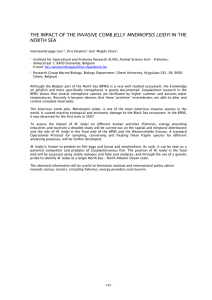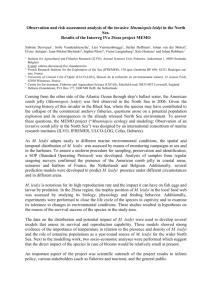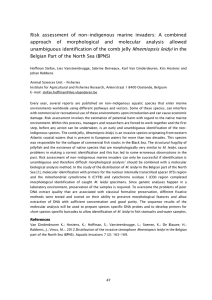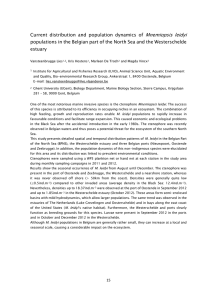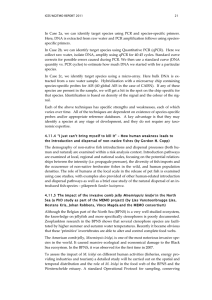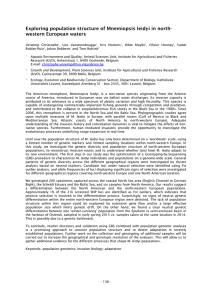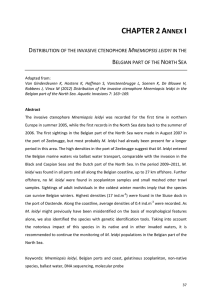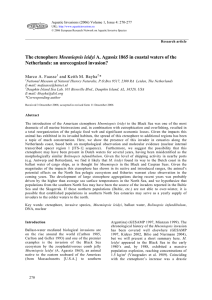among other plankton databases: 'There are several notable plankton databases... world, falling broadly into three categories: the long term surveys...
advertisement
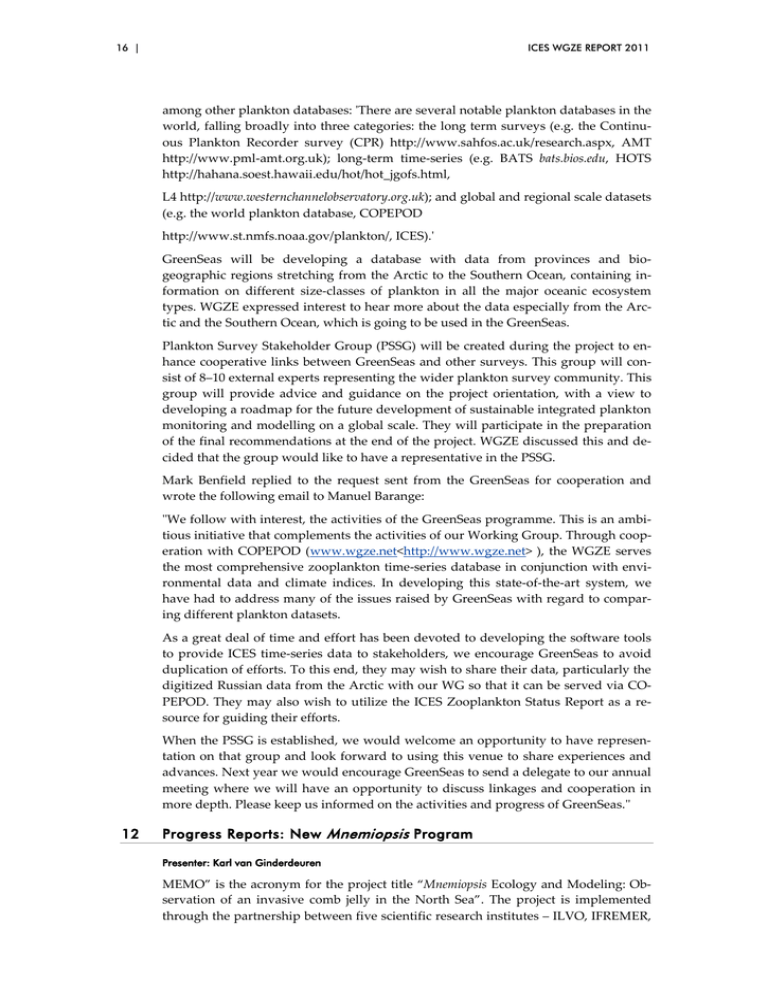
16 | ICES WGZE REPORT 2011 among other plankton databases: 'There are several notable plankton databases in the world, falling broadly into three categories: the long term surveys (e.g. the Continuous Plankton Recorder survey (CPR) http://www.sahfos.ac.uk/research.aspx, AMT http://www.pml-amt.org.uk); long-term time-series (e.g. BATS bats.bios.edu, HOTS http://hahana.soest.hawaii.edu/hot/hot_jgofs.html, L4 http://www.westernchannelobservatory.org.uk); and global and regional scale datasets (e.g. the world plankton database, COPEPOD http://www.st.nmfs.noaa.gov/plankton/, ICES).' GreenSeas will be developing a database with data from provinces and biogeographic regions stretching from the Arctic to the Southern Ocean, containing information on different size-classes of plankton in all the major oceanic ecosystem types. WGZE expressed interest to hear more about the data especially from the Arctic and the Southern Ocean, which is going to be used in the GreenSeas. Plankton Survey Stakeholder Group (PSSG) will be created during the project to enhance cooperative links between GreenSeas and other surveys. This group will consist of 8–10 external experts representing the wider plankton survey community. This group will provide advice and guidance on the project orientation, with a view to developing a roadmap for the future development of sustainable integrated plankton monitoring and modelling on a global scale. They will participate in the preparation of the final recommendations at the end of the project. WGZE discussed this and decided that the group would like to have a representative in the PSSG. Mark Benfield replied to the request sent from the GreenSeas for cooperation and wrote the following email to Manuel Barange: "We follow with interest, the activities of the GreenSeas programme. This is an ambitious initiative that complements the activities of our Working Group. Through cooperation with COPEPOD (www.wgze.net<http://www.wgze.net> ), the WGZE serves the most comprehensive zooplankton time-series database in conjunction with environmental data and climate indices. In developing this state-of-the-art system, we have had to address many of the issues raised by GreenSeas with regard to comparing different plankton datasets. As a great deal of time and effort has been devoted to developing the software tools to provide ICES time-series data to stakeholders, we encourage GreenSeas to avoid duplication of efforts. To this end, they may wish to share their data, particularly the digitized Russian data from the Arctic with our WG so that it can be served via COPEPOD. They may also wish to utilize the ICES Zooplankton Status Report as a resource for guiding their efforts. When the PSSG is established, we would welcome an opportunity to have representation on that group and look forward to using this venue to share experiences and advances. Next year we would encourage GreenSeas to send a delegate to our annual meeting where we will have an opportunity to discuss linkages and cooperation in more depth. Please keep us informed on the activities and progress of GreenSeas." 12 Progress Reports: New Mnemiopsis Program Presenter: Karl van Ginderdeuren MEMO” is the acronym for the project title “Mnemiopsis Ecology and Modeling: Observation of an invasive comb jelly in the North Sea”. The project is implemented through the partnership between five scientific research institutes – ILVO, IFREMER, ICES WGZE REPORT 2011 | 17 ULCO-LOG, CEFAS and Deltares – and led by ILVO. The subject of the research is the comb jelly M. leidyi that was observed in the North Sea in 2006. This research project started on 1 January 2011 and is funded by the Interreg IVa MEMO-2 Seas Programme. In total, €3.5 million is allocated over three years and 20 scientists are involved. The American comb jelly comes from the Atlantic Ocean near the North American coast where it has natural enemies. Presumably it is by ballast water of ships transferred to our region. The ctenophore measures up to 12cm, although in the North Sea and the English Channel they have been observed to be around 1 to 4 cm. It is a voracious animal that feeds on all kinds of fish larvae, fish eggs and plankton. Mnemiopsis leidyi are capable of self-fertilization, so one copy is sufficient to start the reproductive cycle. The cycle takes about 2 weeks. Mnemiopsis leidyi appears to need little energy and has survived two cold North Sea winters so far. The invasiveness of the comb jelly M. leidyi in the Black and Caspian Sea in the 80s and has led to a major change in the marine ecosystem and economic losses due to a decline in fish and shellfish stocks. In 2006 this species was detected in different regions of the two seas area. The spread of M. leidyi in this area is a major concern because of the presence of important spawning and nursery areas and migration routes for many commercial fish and shellfish. The presence and distribution of M. leidyi in the two seas region, and its interaction with potential prey and predators in relation to possible changes in the environment must be closely monitored to avoid similar disasters like in southern Europe. MEMO project has a clear and ambitious goal. The project seeks a better understanding of the identification, biology and physiology of the comb jelly, attendance, behaviour and impact monitoring in the North Sea and the development of models to assess the ecological and economic impact of M. leidyi in the two seas region. This will be achieved through three activities: (1) Development of standard procedures for identification, monitoring and modelling of potential habitat and population dynamics of M. leidyi; (2) Studies of the physiology, eating behaviour and potential predators of the species through experiments and mathematical models; and (3) Evaluation of the potential environmental and socio-economic costs of the impact of the species by an ecosystem-based approach. The ultimate goal is to inform, with the support of the European Union, stakeholders and the general public about the potential risk of M. leidyi on the marine ecosystem and professional activities in the two seas region and to identify possible measures to counter this threat. 13 Progress Reports: Update on the Impact of the Deepwater Horizon Oil Spill on Zooplankton Presenter: Mark Benfield; Rapporteur: Tone Falkenhaug Mark presented ADCP data from the spill site that suggested that zooplankton scattering had decreased following the spill compared with a reference site outside of the impact zone. Changes in mean scattering strength also indicated increased variability in the vertical migration during the oil spill. During the discussion, Roger Harris asked if sediment traps were deployed in the area: No sediment traps were deployed and no oil spill was observed on the seafloor. Roger also asked why did they use dispersants? Mark: Dispersants were used in order to reduce the vapour pressure at the surface and to keep the oil from the coast.
